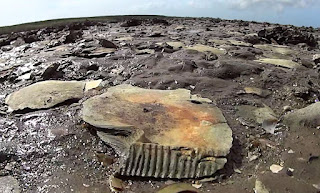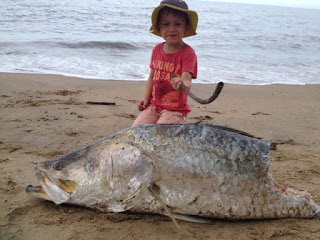In ecology an oyster reef is the classic example of an open ecosystem. In open ecosystems nutrients pass through
the ecosystem whereas in a closed ecosystem, nutrients are mostly recycled. There are no truly closed ecosystems that we
know of; however some of rainforests would come close. Larger coral reefs also have a high degree of
nutrient recycling so are functionally close to being a closed ecosystem. Oyster reefs are open ecosystem because the
oysters feed on plankton imported by water flowing over the reef and the
oysters export frass and sometimes oyster eggs/sperm into the flow. Nutrients come and go and only negligible amounts are recycled. Given their
conceptual importance, I was surprised that so little attention has been given
to oyster reefs.
 |
| Mushroom-shaped oyster reefs on bed rock outcrops at White Cliffs, Captain Cook Highway |
I noticed that oyster reefs were a distinct ecosystem
on tropical Queensland shores about one year ago. Wikipedia defines an oyster reef as a dense
aggregation of oysters that forms a large colonial community. Oyster reefs have their own ecology and can
exist independently of mangroves, coral reefs and other tropical
ecosystems. As oyster reefs are small, ranging
from less than a metre across to patchy reefs a few tens of metres across at
the most, they are easy to overlook.
 |
| Band of oysters on landslide boulders at East Trinity boat ramp (click to enlarge) |
Given that oyster reefs are nature’s equivalent to patches
broken glass, it also took me a while to want to investigate them. Oyster shells can easily cut into human skin. Small pieces of shell often remain embedded in
puncture wounds and cause serious infections.
Wading barefoot across a mud flat studded with oyster covered rocks is a
testing experience as even the mud between the colonies is full of sharp buried
shells. A common way to have this dreadful
experience is to pull up to a beautiful beach with a wide shallow reef flat
that forces you to get out of the boat and walk ashore. Some beaches have oyster covered stones, known as oyster beds, on
the reef flat and these are the ones to be careful of.
 |
| Stony sand flats such as this one at Giangurra often have oyster beds |
 |
| Juvenile oysters cover many of the stones and these have cylindrical spines |
One of the worst places I have ever been was a saddle oyster
reef at the mouth of Saltwater Creek near Cairns Airport. Saddle oysters (Isognomon ephippium) are about 12 cm
across with thin almost circular shells that when closely stacked look like a
bed of axe heads. Silvery dead shells
littered the ground around the reef my first impression of them was of
miniature compressed humanoid skulls.
The circular part of shell is offset to one side like the braincase of a
skull in cross section and the hinge has a series of deep grooves that resemble
tooth sockets. The saddle oyster reefs
stretched right across the bed of a creek that was only millimetres deep a low
tide. I was trapped between a series of
these barriers and could not paddle my surf ski out or walk out as the soft mud
was as deep as my legs were long and stretched for hundreds of metres. It was the most vulnerable to crocodile
attack I have ever been. Having no easy
exit, I decided to investigate the reef properly so that I would never have to
come back, before committing to a two hour slog across the mud flats that
involved sitting on the tip of the ski and kicking with both feet to move just 30 cm.
 |
| Saddle oysters reefs consist of tightly packed vertical shells |
 |
| The surrounding area is covered with their dead shells |
 |
| The shells look like weird skulls |
A milky oyster reef near Pretty Beach on the Captain Cook Highway
lacks the danger but was also a bit depressing.
It is located on the crest of an uplifted coral reef that has very
little living coral or other life. The oysters are only present in narrow bands
around the margins of the coral platforms.
Oysters normally form a horizontal band on rocky shores that is close to
high tide level. As the entire top of
the old coral reef is at oyster level, yet only some places have colonies of
contiguous oysters, some other environmental factors must also be important. I wonder if oyster colonies form much like
snowflakes form with edges of the colony that are subject to the most current
recruiting the most spat. Curiously,
there is little fouling of living milky oyster reefs by other organisms such as
algae and barnacles.
 |
| Uplifted coral reef near Pretty Beach, Captain Cook Highway |
 |
| Looking along the uplifted fringing reef |
Not all reefs are ugly and some oyster reefs are pretty
enough to be photogenic, particularly the shelves of oysters that form on rocky
headlands or on huge boulders that landslides have delivered into the sea. Unsupported shelves of oysters can extend out
for over a metre. Rough seas probably
break off shelves that have grown too wide.
The oysters in the shelves are arranged like a malformed honeycomb into
tall roughly shaped polygonal columns.
Most of the column is solid shell and is formed from layer upon layer of
shell secreted underneath the living oyster.
Some of the solid columns are more than 10 cm long. Unfortunately the columns are weakly banded
and it is hard to count seasonal ‘growth rings’.
 |
| Massive shelf of oysters near Thala Beach Lodge (White Cliffs) |
 |
| Same shelf from other direction showing gap where part of reef has broken away |
 |
| Small oyster reefs in lee of Taylor Point, Cairns |
The ultimate oyster reefs in my opinion are the small unattached oyster
reefs that lie on sand and mud flats. These
reefs are self-regenerating in that the only place new oysters can settle is on
old oysters. Self-sustaining unattached
oyster colonies are not common with only few seen for each kilometre of coastline and
they always occur on the landward margins of wide sand or mud flats. I have also heard that aborigines once
returned old shells to the sea so that new oysters could grow and it would be
amazing if this was the origin of the unattached oyster reefs that I have
observed.
 |
| Unattached oyster reef at mouth of Johnstone River, these oysters tend to get eaten by people. |
 |
| Unattached oyster reefs with milky oysters develop on dead saddle oyster shells |
 |
| An oyster colony in a midden at Weipa, shellfish were the major food source for local aborigines |
All of the oyster reefs prefer relatively semi-sheltered
waters or on exposed coasts, positions where waves are broken before impact. They also prefer large rocks that stand in
deeper water and which are probably less prone to sand blasting during rough
weather. It is thought that the lower
limit of oyster growth is related to predation.
On floating walkways in marinas, oysters only grow near the water
surface and are heavily predated.
Oysters often do much better on the piles within the marina oysters as piles are exposed when the tide recedes.
 |
| Oyster reefs do not like places with high energy wave impacts |
When trying to work out why oyster reefs form where they do,
it occurred to me that oyster reefs might also be a real world example of
DaisyWorld, which is the mother of all ecological theories. Oyster reefs are mostly bright white yet they
live on black rocks. During summer, the
rocks can get super-hot and
suffering limpets stand up on their feet like
mushrooms to get some air under their shells.
However oysters breathe water and must remain tightly closed and like
daisies, they cannot move so heat must be a critical issue. In Daisy World, white daisies cool the world
by reflecting sunlight so could oyster reefs work this way too. The next step is to look for scientific
papers as surely this topic has been researched. If not, doing some data collection on
temperature differences between bare stone and oyster colony would not be too hard.
 |
| Oysters seem to do much better in colonies than they do as scattered individuals |
 |
| One of the few rocks with scattered oysters, showing lots of dead oysters |
In other countries and other parts of Australia, the habitat and ecosystem services
provided by oyster reefs are highly regarded. In north Queensland, the rich variety of habitats means that the contribution of
oyster reefs to local species diversity is quite low. However, there are organisations springing up to
restore and recreate oyster reefs that have been destroyed over the years,
including the
Shellfish Reef Restoration Network. In early Australia many oyster reefs
destroyed for various reasons. Some were
mined and the oysters burnt to create lime for concrete. In many places there has been a major loss of oyster reefs.
 |
| NSW Oyster Fisheries 1883, Source: State Library of Victoria |
Oyster reefs provide a complex three dimensional space where
creatures could live, however the position of oysters at the top of the tidal
range probably limits the number of species that could make use of that
potential habitat in north Queensland. I
did not observe much biota making use of the habitat provided by oyster
reefs I have examined. Crabs including
stone crabs and half crabs sometimes shelter under unattached oyster reef on
tidal flats and algal turf sometimes occurs on old dead shells.
 |
| Well developed oyster reef often has fissures and holes |
 |
| This older reef has algae turf on the matrix of old dead shell |
 |
| Large shelfs can collapse, creating oyster boulders that provide habitat for other creatures |
 |
Oyster shells collected from beach that probably come from broken down reefs
1. Due to crowding the oyster lives in an ice cream cone shaped space inside the column of shell
2. Column seen from bottom, showing robust outer wall and layers of shell sealing
of the unwanted space below the living oyster
3. Most columns have a stripe on one side and I assume this is the attachment surface
4. This column (oyster shell) is 9 cm long, but columns can get a fair bit longer |
Oyster drills are the most common visible
natural predator of oysters. In NSW oyster beds that once extended from the high tide line to the bottom of the coastal harbours but sub-tidal colonies were wiped out by introduced mudworms. Humans are
probably the main predator of the remaining oyster beds and reefs in the upper intertidal zone.
Indigenous people and to a lesser extent other people scour most of the
coastline near Cairns looking for oysters which they mostly consume on the
spot. In accessible sections of coast,
oyster populations are often depressed by over harvesting. However given the notoriously poor diet of
indigenous people, fresh oysters are probably a very important dietary
supplement.
 |
| An Oyster Drill - Morula marginalba |


























